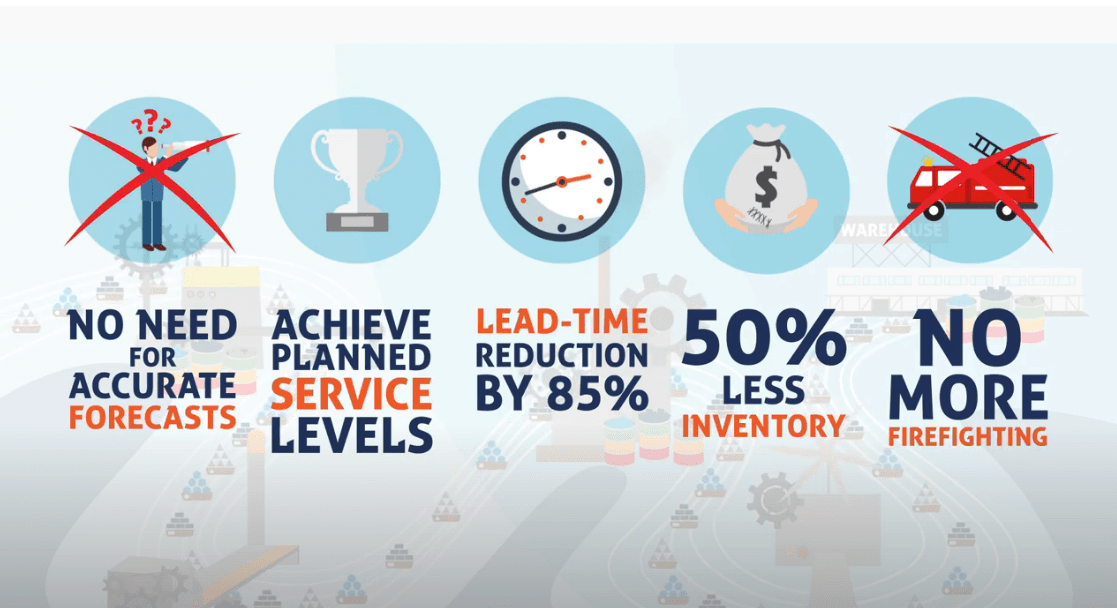How is DDMRP Buffer Stock Different from Safety Stock?
Executive Summary
- The Demand Driven Institute (DDI) claims that buffers stocks are not related to safety stock and accuses those that make the correlation as not understanding DDMRP.
- We evaluate if the DDI correct in this assertion.

Introduction
One of the core areas of DDMRP is how much it relies on setting buffer stocks. As we cover in the article How Accurate is DDMRP’s Explanation of Forecasting?, DDMRP does not use the forecast as an input to drive orders per se but is only used to set the buffer stock.
Our References for This Article
If you want to see our references for this article and related Brightwork articles, see this link.
DDI on Buffer Stock
The following is a video explaining the buffer stock concept by the DDI.
Decoupling Points and Decoupling
DDMRP uses the term decoupling points, which will be (and should be) confusing to many, but this is simply the buffering of demand with the inventory. All supply planning systems — unless they are made to order, use decoupling points. However, be careful in assumptions in this area. As we will see, the DDI has chosen to use the term “buffer” in a very peculiar way.
The video states that ordering is performed along with actual demand and not the forecast. This is not entirely true, as the order is triggered by the buffer stock demand based upon the forecast — among other factors.
The video says that the entire system is managed autonomously, which is not true. Forecasting does not go away with DDMRP — as DDI states itself, and planners must set buffer stock. This, along with several other factors, should be enough to illustrate that DDMRP cannot be described as an autonomous system.
DDI’s Overuse of the Term Decoupling
As a general term, decoupling can be considered reasonably accurate, but DDI’s use of the term decoupling is quite confusing in other areas.
While it may be acceptable to use the term to describe a stocking location as it decouples supply from demand — the problems come when the DDI uses the term decouple to mean shrink supplier lead times — which is not actually shrinking the supplier lead time. DDMRP does this by inserting more inventory. Naturally, higher than expected demand has a shorter lead time from the company’s internal stocking location. This is because the company has the stock item and can satisfy demand from stock rather than stocking out and needing to place a new order.
This is extremely confusing, and some might say deceptive use of the term lead times. DDI also does an inferior job of explaining what lead time it refers to and leaves it up to the reader to figure it out for themselves.
Nowhere in the DDI documentation clarifies that the lead time being described as shrinking is the company to customer lead time or the stocking position to customer lead time.
To add to this unnecessary confusion, there was already a term available to describe this exact thing, which is referred to as effective lead time, which I cover in the article How to Understand Effective Lead Time Better. I am not sure who first coined the term effective lead time, but inventory optimization and multi-echelon software vendors popularized it. Effective lead time is the lead time that the customer perceives. It is conditional and depends upon stocking and delivery conditions given a particular scenario. If, for instance, a store is out of stock of an item, the effective lead time is the time to receive delivery from that location’s replenishment location.
And this confusion on the use of the term decoupling leads to one explanation of buffer stock.
Supply order generation — all relevant demand, supply and on hand information are combined at the buffer to produce an “available stock” equation for supply order generation. – DDMRP Buffer Explanation and Simulation
This stock definition is already extremely well known as either the planned stock on hand or the available stock.
As this term was already established, why was an entirely new term created called buffer to describe this stock category? The DDI could have kept the established term and stated that the way it calculated the planned stock on hand was distinct from other supply planning methods. See the article How to Best Understand Buffer Stock, to see how the vendor PlanetTogether uses the term buffer stock accurately.
There is a secondary issue here because DDMRP claims to be multiechelon software, but it is not. We cover this in the article Is DDMRP Multiechelon Software? Therefore DDMRP claims to be multiechelon but isn’t. Still, it almost appears as if the developers of DDMRP do not understand multiechelon inventory optimization software. They had a term available to them and popularized by multiechelon inventory optimization software but did not use it.
No More Expediting?
Something else that is dubious in the video is that expediting is eliminated.
DDMRP does not eliminate expediting and variability. No supply planning system will do this.
In fact, in most cases, and depending on the item’s forecastability, it would increase expediting and variability as it cannot see future demand. Or the future demand is only accounted for in the buffer stock.
As we will see further on, this again is due to DDMRP carrying more stock. However, we will also see that the DDI then contradicts this obvious conclusion by stating that the average inventory declines.

These claims are made in the video above.
- No Need for Accurate Forecasts?: Aren’t the forecasts being used to size the buffer stock? Less accurate forecasts mean more buffer stock than is necessary. The entire claim that the forecast is not used to drive orders but is input to the buffer stock is extremely confusing.
- Achieve Planned Service Levels?: How does DDMRP improve the ability to meet planned service levels? All that is occurring is the forecast is placed into the buffer stock rather than used to drive order outside of the buffer stock demand. How is this giving the company more able to meet service levels? Given the other claims, it seems to come from simply carrying more inventory.
- Lead Time Reduction by 85%: At first glance, one might ask, “How does any of this lower lead times?” One might harken back to the unfulfilled lead time reductions from Lean proponents that never came true. However, this is not the right pathway of inquiry because the DDI is playing a word game with the term lead time reduction. In this case, DDI makes the following claim regarding lead time reduction in the document DDMRP Buffer Explanation and Simulation.
Lead time compression — decoupling supplier lead times from the consumption side of the buffer, lead times are instantly compressed.
I never recall the term lead time reduction or compression being used in this way.
First of all, what lead time is being discussed? With more inventory, the lead time for higher than expected demand is shortened. But typically, this is not the correct or accepted usage of the term lead times.
Anyone – using DDMRP or anything other supply planning method can accomplish the same goal by simply increasing their average stock levels.
- 50% Less Inventory: This is getting repetitious, but why does inventory declined by 50%? That is considered an enormous amount, by the way. DDMRP has presented a different approach to planning, but nothing in what they present would indicate this reduction. In their study, which we cover in the article ” Repackaged Lean as DDMRP, ” inventory reduction was far less than this. Furthermore, as the primary strategy of DDMRP is to increase inventory to do things like “decouple” supplier lead times — it is odd to see a claim of reduced inventory. To achieve the other DDI claims, the inventory level would have to increase, not decrease.
- No More Firefighting: This is an extension of the no more expediting argument presented above. But it is not at all clear the expediting would be lowered. In the case of, say, some demand histories, such as seasonal, firefighting would most certainly be increased — but that, of course, depends upon how much the forecast is incorporated in the buffer stock. Again, DDI makes the following claim in the document DDMRP Buffer Explanation and Simulation, which leads back to the same cause that we have covered thus far from where benefits emanate from DDMRP.
Shock absorption – dampening both supply and demand variability in order to significantly reduce or eliminate the transfer of variability which creates nervousness and the bullwhip effect.
This can be translated into carrying more inventory.
Unless DDMRP can be more precise than MRP, which is difficult as it means reducing the effort put into forecasting, the only answer can come from more stock being carried.
Calculating Buffer Stock
The following is an explanation of how buffer stocks are calculated.
For each decoupled part, we’ll use a certain buffering level. The total buffer will consist of 3 zones: green, yellow and red.
The way these zones ares used will be detailed later when we discuss demand driven planning. For now a brief summary of each zone should be enough:
The green zone is used for supply order generation. It determines order size and frequency.(emphasis added)
The yellow zone is used for inventory coverage.(emphasis added)
The red zone is used for safety purposes.(emphasis added)
The size of each zone, and therefore of the total buffer, will be different for each part. This is accomplished in part by creating material groupings (buffer profiles), and in part by individual material traits.
Only Buffer Stock Stops the Bullwhip Effect?
Safety stock exists because there will be variation from what was planned versus what was actually needed. Safety stock logic launches AND expedites a new supply order when unexpected variation causes inventory to drop below a predetermined level. This can act like a grenade thrown over the supplier’s fence. This can setup a “bullwhip effect” in most supply chains. Safety stock can protect only one side of the relationship. This protection can be either inadequate or capital intensive depending upon the volatility of demand. Replenishment buffers are designed to protect both sides of the position. On the customer side it allows supplier variability to be dampened thus promoting availability. One the supplier side it allows for natural aggregation of real demand and consumption. This naturally dampens variability from the demand dize AND allows for batch performance that relates to actual demand. – Replenishment Positions Versus Safety Stock: Why Are They So Different?
It is not at all clear how safety stock naturally does this. Safety stock could do this — if the safety stock value were set too high. For example, the standard dynamic safety stock calculation will set the safety stock too high for product locations with high variability of demand but low forecast error, as we cover in the article Experiences with Dynamic or Extended Safety Stock. However, this is not a natural feature of safety stock.
Actual Demand to the Rescue?
Throughout this explanation, DDI peppers in the term “actual demand.” This is to distinguish between the forecast. However, there are two problems with this. The first is unless you are in a make-to-order environment, there is a strong limit to how much you can use actual demand. This is a constant inconsistency with DDI in that they often put down the forecast, but then when questioned, they change their position to “we do use the forecast but for the buffer stock creation.” Yet, in this explanation of buffer stock, they again diminish the forecast in favor of “actual demand.”
Other parts of this explanation are not at all clear.
How is DDMRP’s buffer stock calculation “naturally” aggregating or dampening? Also, which safety stock method is being castigated here because there are several ways to calculate safety stock.
High Forecast Error Creates Burdensome Stock Levels when Safety Stock is Used But Not When Buffer Stock is Used?
DDI goes on to say about safety stock.
The definition clearly describes that safety stock is a supplementary position to guard only against variation. Consider the dramatic increase in variation across every supply chain as complexity increases worldwide. If forecast error is high then the safety stock supplementary position can become quite an extraordinary financial commitment to statistically cover that error. – Replenishment Positions Versus Safety Stock: Why Are They So Different?
The term complexity is an imprecise explanation of what has happened to demand history.
It is more accurate to say that demand histories have been eroded by a conscious decision by marketing and sales in companies, as we cover in the article How to Understand Forecasting Lumpy Demand, which has had the result of creating more intermittent demand patterns. These are not inevitable outcomes — and some companies — like In n Out Burger and Trader Joe’s described in the article link above, have prospered in part by not doing things that make the supply chain more difficult to manage.
On the last point, if variability is high, then safety stock is high as well. However, DDI’s buffer stock does not give one a get-out-of-jail-free card on variability. As the environment does not change (that is, make-to-stock versus make-to-order), DDI’s buffer stock faces the same challenges in accounting for variability.
However, the following quotation from DDI again claims it can account for variability in an entirely new way.
Replenishment positions are not susceptible to the forecast error or the order spikes that typically overwhelm or grossly inflate statistical safety stock positions. This is because, with regard to replenishment positions, only sales orders are considered. Forecasted orders are simply not part of the supply generation question. – Replenishment Positions Versus Safety Stock: Why Are They So Different?
Here DDI states it only uses sales orders — therefore, its replenishment “position” is pulling — even though the safety stock includes the forecast and is both push and pull. Once again, in a make-to-stock environment, which is the vast majority of environments as we cover in the article The Reality of Make to Order and Forecasting, one cannot simply switch to a make-to-order environment if one is in a make to the stock environment.
Only Replenishment Positions Decouple Lead Times?
One of the obvious differences between replenishment positions and safety stock is their relationship to lead times and where they are placed. First and foremost, replenishment positions decouple lead times whereas safety stock does not. – Replenishment Positions Versus Safety Stock: Why Are They So Different?
The term “decouple” is not a precise way of explaining the role of excess inventory that is deliberately held. However, if one wants to use this framework, there is no reason to think that the excess inventory carried from DDMRP’s buffer stock is any more decoupling than safety stock. This is another mischaracterization of safety stock. The way that DDMRP describes it, safety stock does not appear to do almost anything of value — while buffer stock appears to have almost magical qualities.
Safety Stock is Mostly Static?
In most cases, safety stock is relatively static. There are some very sophisticated and dynamic safety stock systems. All of these systems attempt to take forecast variability and combine that with expected changes in demand including promotions and seasonality to adjust the safety stock levels to give better protection with certain windows of time. While this is obviously superior to static positions, the dynamic portion of this approach is limited to the safety stock zone only – the rest of the on-order and on-hand inventory still corresponds directly to planned orders. – Replenishment Positions Versus Safety Stock: Why Are They So Different?
The first part of this paragraph is true. And it is a point we observe in the application we developed to calculate safety stock external to the MRP system, which is explained in Brightwork Explorer and Safety Stock Calculation. And one does not need to use the dynamic safety stock calculation within the ERP system, and in fact, most company’s don’t. However, static safety stock settings are primarily used because companies invest little in maintaining their systems. Not because this is necessarily the case. Although ERP systems and external planning systems also make it difficult to review safety stocks related to one another.
We are absolutely no fan of how safety stocks are maintained. However, there is no evidence that DDMRP buffer stocks are an improvement, and there is not just one way of calculating safety stock. We modified the standard dynamic safety stock and created a better dynamic safety stock, but it is not the best for all companies. We have concluded that a customized dynamic safety stock calculated external to the primary supply planning system is the most desirable course to follow. However, convincing companies of this has been a difficult task.
As for the last part of the paragraph, this is another critique of using the forecast to create orders or a critique of forecast-based planning. Our previous comments about the inappropriateness of applying a make-to-order system to a make-to-stock environment apply here.
How DDI Convolutes Terminology
What becomes quite apparent is that the term buffer stock is misnamed. The definition of a buffer is to lessen or moderate the impact of something.
Therefore, a buffer stock should, logically, only refer to safety stock. Why are order size and frequency (Green) and inventory coverage (Yellow) included in the buffer stock?
This naturally creates a lot of confusion as to what is a buffer stock, as 2/3 of the buffer stock components have nothing to do with lessening or moderating anything.
The description of how to set up buffer stock continues.
Buffer Profiles
Parts are grouped according to its characteristics. It is suggested that you group them according to:
- Part type: manufactured (m), purchased (p), or distributed (d)
- Decoupled lead time: short (s), medium (m), or long (l)
- Supply and / or demand variability: low (l), medium (m), or high (h)
This is only a suggestion, as the actual profiles created depend on the nature of the business. According to the buffer profile a part falls on, we should be able to configure some factors that will later be used for buffer sizing:
- a lead time factor: the longer the lead time, the smaller this factor. For example, 0.2 for long lead time, 0.5 for medium, and 0.8 for short.
- a variability factor: the more variability, the higher this factor. For example, 0.25 for low variability, 0.5 for medium, and 0.75 for high variability.
Individual Part Attributes
The following attributes, which are also used for buffer sizing, are different for each part:
- Average daily usage (ADU) – which can be past or forward looking, or a mix of these
- Decoupled lead time (DLT) – calculated as explained in the previous post
- Minimum order quantity (MOQ), if applicable
Calculating Buffer Zones
To calculate the buffer zones we’ll often use the average usage over the entire decoupled lead time (ie, ADU x DLT). Though there is no standard DDMRP name for this value, I will refer to it below as Lead Time Usage (LTU).
Each zone is then calculated as:
Green zone: LTU x Lead time factor. Exception: if MOQ is higher, use MOQ instead.
Yellow zone: LTU.
Red zone: sum of “red base” (LTU x Lead time factor) and “red safety” (variability factor x red base). – SAP Blogs
I include this portion of the quote for informational purposes. I can’t think of why I would want to do anything described in this explanation to plan an item.

The DDI receives our Golden Pinocchio Award for using word games to drive to its proposed benefits.
Conclusion
The misnamed buffer stock is made up of three components, only one of which is safety stock. Therefore, while it is named as if it is only safety stock, it is, in fact, the overall inventory. Buffer could be justified as a term in that the stock level “buffers” the supply from demand. But this is an extremely imprecise usage of the term. It immediately led to confusion and should have been caught early in the development of DDMRP when they were settling on names and descriptions.
Confusion, Most Definitely…But Confusion Started by Whom?
DDMRP proponents complain about the confusion around buffer stock. However, a major part of the confusion is the misnaming of the overall stock calculation in DDMRP being called “buffer stock.” It also renders some of the discussions around buffers stocks I have had with Chad Smith and other DDMRP followers extremely odd. Why did they spend so little time describing the components to buffer stock, and why did they not interchangeably use the term overall inventory?
Most of the explanations around DDMRP refer to it as being based on actual demand — or a consumption/reorder point method. If the forecast is used in the buffer stock calculation — then is this earlier assertion really true?
If I paid a group to devise a maximally confusing way of explaining a supply planning method, I don’t think they could have outdone the DDI.
See this definition of buffer stock in economics.
Notice that the term buffer is used accurately here to describe a stock held for a moderating effect.
The way DDI uses terms like lead times, buffer stocks, decoupling, and forecasts..
- For example, the lead time is reduced, but it isn’t
- The buffer stock manages variability, but it is not safety stock
- DDMRP does not use the forecast, but then it does, and for the buffer stock
..make it appear that the DDI uses terminology in a deliberately misleading way — where part of understanding DDMRP is keeping up with what is a word game constructed by DDI.

DDI and DDMRP proponents routinely accuse DDMRP critics of not understanding DDMRP. However, the DDI must take a fair share of the blame for creating such a confusing set of terms and explanations for DDMRP, as well as for seeming to provide inconsistent statements about how DDMRP works.